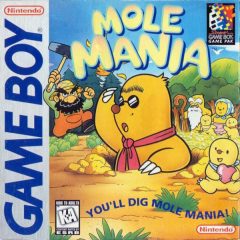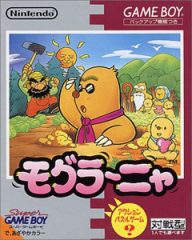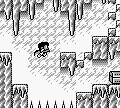by Ron Duwell
Since the dawn of the modern video game in the mid 1980s, the names Mario, Zelda, and a host of Nintendo’s other multimillion selling franchises continue to be synonymous with the name of their long time game producer, Mr. Shigeru Miyamoto. What game produced by a man with such a well known library of creations could possibly be considered obscure or hardcore these days? Longtime fans may bring up Devil World, which was only released in Japan and Europe for the Famicom/NES way back when, but there’s one even more underground. While his legacy has been long regarded as one of both major commercial and critical success, a single game released in America has continued to evade all but the most faithful of Nintendo’s ever growing fanbase. Squirming for attention beneath the pile of Miyamoto’s towering achievements, Mole Mania is an enjoyable action puzzle game that no fan of Nintendo’s guru should pass off playing any longer.
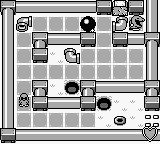
Mole Mania (Game Boy)
No doubt the reason Mole Mania enjoys so little fanfare was its rather unfortunate launch window in both Japan and America. The game was released in Japan in July of 1996, no later than four months after every Japanese boy in the country had been swept up in Pokémania earlier that February. It goes without saying that not many Japanese kids were willing to put their Pikachu training on hold for a day or two for a chance to blunder their way through some quirky puzzle game.
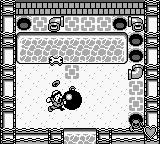
Mole Mania (Game Boy)
The game fared no better in America either, hitting the shelves in February of 1997. This point in the Game Boy’s American lifespan falls smack in the middle of what has been retrospectively seen as a rut for the system. Nothing huge had appeared in the system for several years, nor had America’s interest been reinvigorated yet by the Pokémon games. The Nintendo 64 had also just seen a successful first year and was soaring at the peak of its popularity, so a dopey puzzle game starring a cute mole didn’t stand a chance against new titles such as Mario Kart 64 or GoldenEye which cost a whopping $70 each. For the tightly budgeted, a dated looking puke green-and-white relic would have to wait in turn against the new magic of 3D.
Mole Mania (Game Boy)
Despite its unsuccessful launch, it was met with decent reviews…all two of them. Those who had managed to discover it found a fun little gem that served as an excellent way to waste away a few lazy afternoons or a long car ride, and much like most Miyamoto games, still holds up today.
Mole Mania was developed by a company now known as Pax Softnica. While not exactly big time these days, developing throw away games for Japanese cell phones and other graphical programs, the team’s credits impressively feature assisting Ape Inc. and HAL Laboratories on the first two Mother titles. Before helming the role of Mole Mania‘s director, Masayuki Kameyama, a one time level-designer and director for several Game Boy ports including Donkey Kong, had also wrapped up his directorial debut with the first entry in Nintendo’s popular Wave Race series, another Pax Software Game Boy project, several years earlier.
Mole Mania (Game Boy)
The game stars long lost gaming icon Muddy Mole, a common every day mole with a beautiful mole wife and seven cute mole children. He and his family dwell under the gardens of a nasty farmer by the name of Jinbe. Upon returning from his daily raiding of Jinbe’s vegetables, Muddy Mole finds his family kidnapped by his nemesis with a ransom note calling Muddy for a fight. Armed with nothing but his claws and the advice of his senile father, Grandpa Mole, Muddy sets off through seven challenging levels filled to the brim with cabbages, bombs, and Tyrannosaurus Rex’s. Just what the hell kind of farm does Jinbe run anyway?
Mole Mania (Game Boy)
Each level acts as a maze which Muddy must navigate his way through. Laid out over a grid, the mazes begin as small as 4×4 screens but quickly expand to the size of 7×7 screens by the time Muddy reaches the final level. Each screen holds a puzzle, and the objective for every puzzle in the game is the same…destroy the stone wall with the bomb. In the vein of The Adventures of Lolo series, Muddy goes about solving these mind benders by precisely aligning barrels and blocks throughout the puzzles in attempts to lob the bomb up in a straight line with the destructible wall.
Mole Mania (Game Boy)
Mole Mania‘s unique catch comes from Muddy’s one natural abilities as a mole…to burrow. Beneath each puzzle lies yet another actively connected plane which he can access by creating a hole. Underground, Muddy can tunnel beneath impassable walls and access previously unobtainable items, or he take shelter from the nasty enemies above for several seconds. In a precursor to the stealth action genre, Muddy can also poke his nose out from his hole to spot if an enemy will step on him should he emerge. Holes must be created in almost every puzzle to give Muddy his needed leverage to toss the bombs, but creating too many holes can completely ruin a puzzle attempt. Should a hole block a rolling bomb’s path, the bomb will simply fall into the hole, and Muddy must start the entire puzzle from the beginning. Finding a “hole balance” is a must in every screen of the game.
Mole Mania (Game Boy)
So, in short, Muddy must position objects in the stage and use them to roll a bomb into a fence. It’s a pretty easy premise that anyone can jump into…
Muddy Mole
…but only the patient can master! For such an innocent and inviting game as Mole Mania appears to be because of its cute box art and whimsical story, it certainly knows how to pull the punches. Mole Mania‘s puzzles are hard. Damn hard. Damn hard and BIG. After a cozy tutorial through the first level or so, Muddy soon finds his way hurling barrels over warp panels or tossing the bomb through path bending elbow pipes in areas where the ground looks like Swiss cheese. Each new level adds another element Muddy must learn to contend with in addition to his piles of troubles already. Sooner or later, even spikes find their way into the game, planted in the most troubling places, stealing Muddy’s already hindered movement.
Mole Mania (Game Boy)
Of course, not only must Muddy solve these abominations, but he must do so dodging every species of twisted animal known to man. Alligators, T-Rex’s, penguins, puffer fish, and canaries all scatter themselves through the puzzles almost too inconveniently for Muddy. What the hell kind of garden is this? Muddy also moves only in four directions and rather stiffly along a grid (Link’s free movement in Link’s Awakening won’t be found here) nor can the chubby dude jump either, so dodging enemies in tight quarters is impossible without turning back or taking damage in most areas. More often than not, panic leads to a stupidly placed hole, and again… ruins the puzzle.
Mole Mania (Game Boy)
In traditional Mega Man fashion, a boss fight awaits Muddy at the end of every maze. Each of these baddies can only be defeated through the superiority of brain power. Using the new elements introduced in the levels, both puzzle solving ability and precise twitch skills are needed to set your enemies up into a situation where they hurt themselves rather than receive damage directly from Muddy. Occasionally, Muddy will have to throw a bomb or three at enemies, but only after he has laid the trap and his foe lays vulnerable. Only upon beating these adversaries can Muddy rescue his children, although stealing their power would have been a lot nicer. By the end of his journey, Muddy will have whooped a boxing kangaroo, a pissed off sun, a one ton weight, a mother hedgehog and her children, a wrench flinging plumber, two weight lifting brothers, and a grumpy snowman. Jinbe keeps interesting company is his garden from hell.
Mole Mania (Game Boy)
Jinbe’s garden seems to span several continents. Over the course of the game, Muddy travels through the Beach Garden, the Snow Garden, the Jungle Garden, and even the Castle Garden. While these level designs come off as almost cliché in the retrospective views we have today, the blatant changes in environments considering Muddy never once leaves the garden are pretty funny. There’s no subtlety in giving players diverse environments to play in.
Mole Mania (Game Boy)
Up completion, players have the opportunity to gain 100 points or a perfect score for their progress in the level. Points come from finding cabbage, conquering puzzles, finding all assisting items like maps and compasses, completion time (usually the stinker), and the defeating of a bonus stage hidden within every maze. Perfectionists will certainly get much more out of this game than someone playing it as an adventure game just to breeze through.
Mole Mania (Game Boy)
By the time players have mastered all these infernal conundrums, should they have a friends who were also savvy enough to grab a copy of Muddy’s adventure, an elaborate and fun multiplayer option also comes packaged with the game. As opposed the typical puzzle games where one player must stack and knock over blocks faster than the other, Mole Mania‘s multiplayer throws an original spin on its core gameplay roots and turns out to be one of the most original multiplayer experiences on the Game Boy.
Mole Mania (Game Boy)
One player controls Muddy and the other controls Jinbe. Matches between players are broken up into two rounds, and rounds last a minute or until Muddy gets his due. The player controlling Muddy must dig holes and attempt to steal cabbage while the player controlling Jinbe attempts to whack him with his tools. Hitting Muddy depletes his health, but missing creates a hole giving Muddy an extra way to score, so wildly swinging the hoe around like a crazy person is the quickest way to lose. Jinbe can also fill in holes taking Muddy’s ability to score. Both players must find a balance between creating opportunities to gain or deny points as well as putting a quick end to the round by stealing all the cabbage or killing Muddy. Once a round is finished, roles switch and the winner is determined by whoever thieved the most cabbage from the other player or whoever stole every cabbage faster.
Mole Mania (Game Boy)
No only is this a wholly satisfying and challenging puzzle adventure, but the game also looks very pleasant as well. Maybe it’s just sentimental attachment, but the original character art from Nintendo Power Volume 93 used to promote the game first exposed me to this little known art style known as “anime.” Indeed, Mole Mania was a first step into realizing the difference between American and Japanese art style. While not so special or unique any longer, the cute character art and heavy contrast between Jinbe and the moles is very charming.
Muddy Mole
In game, much of the game’s scenery and sprite-work is highly reminiscent of Link’s Awakening, the biggest and most detailed game created for the Game Boy. Every sprite has been animated nicely, with the larger bosses being exceptionally impressive, and the amount of detail put into the obstacles and environments is staggering considering the limitations of the hardware being used.
Don’t expect the same pleasure from the music however. Taro Bando, the game’s sound coordinator, managed to take the blips and clinks of the Game Boy’s weak sound capabilities and really transform it into something more ear piercing than the system had ever really projected. This game’s evil and repetitive soundtrack will haunt you for hours afterwards.
Mole Mania is the result of what happens when smart game developers take a very simple premise and think of how to expand it in millions of smart ways. Every Mario game basically boils down to jumping, and Mole Mania boils down to its core premise of aligning shots and digging. The number of puzzles extracted from these two core ideas is staggering and the influence of Shigeru Miyamoto and his ability to create something out of nothing can easily be seen here. Masayuki Kameyama’s experience with the limited Game Boy technology and similar gaming philosophies as seen in Donkey Kong for the Game Boy also bloom to full fruition here in what should be the highlight of his career.
Mole Mania (Game Boy)
Regrettably, Mole Mania remains relatively unknown. Muddy wasn’t a playable character in Nintendo’s expansive nostalgic opus Super Smash Bros. Brawl, nor did the poor guy even get his own trophy. The only mole to get any recognition in that game was that ramblamatic asshole Mr. Resseti from the Animal Crossing games. I believe I’ve discovered the fate of Grandpa Mole. At any rate, this is actually pretty shocking as initial reports from Super Smash Bros. Brawl indicated Masahiro Sakurai as being interested in giving Muddy the full “playable character” treatment and even featured him as a selection on polls during the game’s development period. However, even after those reports, Muddy failed to materialize at all in the final product. Very fishy Nintendo…
The game hasn’t even garnered a rabid cult following to advocate its true potential as a great series or simply as a fun standalone game the way other brilliant yet unfortunate Nintendo franchises like Earthbound have. Even in the most inner circles of the gaming community, the game rarely if never receives mention when Miyamoto’s ongoing career and influential legacy get thrown into conversation. Nintendo has never really been known to follow through with financial failures, generally sticking to their big guns to bring in the cash and flushing the rest away. Mole Mania was about as big of a flop as they could have imagined. Future outings with Muddy Mole seem grim, but taking a step back and truly looking at this game, anyone can see the potential for a modern day sequel.
Taking into account the rapidly growing casual market and their obsession with puzzle games, why couldn’t Mole Mania 2 be a success? The crowd bought into the risky Professor Layton, one of the few games which found a balance between what the casual markets sees as “fun” and the hardcore crowd sees as “game-culturally significant.” Not to mention the game is a perfect handheld release, constantly saving itself and allowing an easy five to ten minute playing session for those hard to get puzzles during the short bus rides to work. Doesn’t Nintendo currently have the most popular handheld on he market, aimed directly towards those people who crave to be occupied during those short bursts of time? With the correct presentation and proper direction (not to mention good marketing and a much more intelligent release window), the welcoming artwork and easily accessible premise of the original Mole Mania could be expanded into a sequel which could be well received by both of the major gaming crowds.
Of course, Mole Mania could also continue to go down in the outskirts of history as one of Miyamoto’s biggest financial failures yet surprisingly strong video games. It’s up to Nintendo, really, and who really knows what their sleeves hold these days.
In 2012, Nintendo gave the title another chance and released on the 3DS Virtual Console.
Thanks to MP83 for the Super Game Boy comparison pics.
Links:
Mogurānya Official Japanese website

